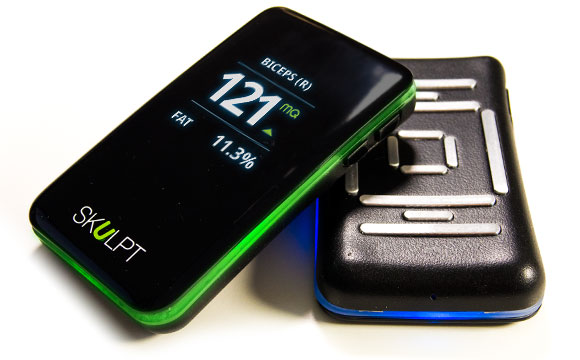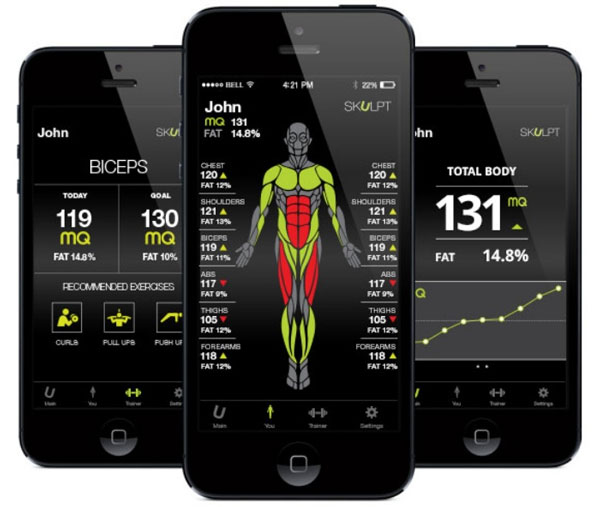Skulpt Aim Review
Skulpt Aim is a new fitness tracker that lets you measure your muscle quality and body fat percentage simply by holding it up to your skin.
Find out everything you need to know about Skulpt Aim today in our review!

What is the Skulpt Aim?
Skulpt Aim is a fitness tracker that measures things you wouldn’t normally measure with a fitness tracker, including body fat percentage and Muscle Quality (MQ).
You press the metallic sensors of the fitness tracker against your skin, and the tracker can measure changes over time.
The device was made after a successful IndieGogo campaign in January 2014. That campaign set out with the goal of raising $100,000 in funding. By the time the fundraiser was complete on January 12, 2014, the company had raised $398,929 in total funds.
Basically, you hold the Aim up to different muscles in your body. It uses its sensors to get data from those areas, and then analyzes that data to provide your body fat percentage and MQ score.
Once those measurements are complete, Aim will send the data to your iPhone or Android device via Bluetooth.
The device itself is about the size of a deck of cards. It’s curved along the back and made from plastic and a rubber-like material. This material is designed to safely absorb small amounts of moisture without damaging the device. There’s also a small bezel along the edge that causes the device to appear to glow while in use.
The front LCD screen displays the two numbers: body fat percentage and MQ. The Aim can’t measure anything else: it just measures those two things. So if you need an all-in-one calorie tracker with GPS functionality, then the Skulpt Aim isn’t it.
How to Use the Skulpt Aim
The Skulpt Aim promises to be easy to use. You hold the Aim up to bare skin on different parts of your body. The device takes measurements at each spot, and then analyzes that data to determine muscle quality and body fat percentage.
In one test video showcasing the Aim, the manufacturer recommends placing the Aim against your biceps, triceps, shoulder, chest, abs, forearms, lower back, upper back, quads, glutes, hamstrings, and calves to get the most accurate measurement.
Aim actually promises to measure 24 different muscle groups in total. Each measurement takes 1 second.
Anytime you want to update your profile, you run the device over your body and allow it to collect its data. You’ll need to hit each muscle group listed above to get the full profile of your body fat percentage and MQ.
Once the measurements are complete, the Aim will analyze the data and display your body fat percentage and MQ score.
What do those results actually mean?
You probably know about body fat percentage, which is the percentage of your body that is fat (as opposed to bone, muscle, and body tissue). But muscle quality is a custom measurement created by Skulpt. Here’s what those MQ numbers mean:
— 80 MQ: Needs work
— 100 MQ: Average
— 120 MQ: Fit
— 140 MQ: Athletic
— 160 MQ: “Skulpted” (that’s not a typo)
After you take your measurements, your MQ and body fat percentage will appear directly on the device. Each measurement is displayed as a digital number along with a “dial” around the outside ranging from “Needs work” to “Skulpted”. A small arrow will point to where each number is on the scale.
How Does Skulpt Aim Work?
According to the device’s IndieGogo page, it relies on something called “Electrical Impedance Myography (EIM)” to get accurate measurements.
EIM was developed by Seward Rutkove, MD, who is a professor of neurology at Harvard Medical School. He also happens to be the co-founder of Skulpt Aim.
EIM was developed as part of a joint effort between Harvard, MIT, and other top universities. It relies on using small sensors to apply small amounts of current into your muscles. That current flows different based on how “fit” a muscle is.
When you apply Aim to your muscles, it sends a small electrical current into your body and reportedly measures “thousands” of data points for each muscle.
Then, it runs that data through an algorithm to turn it into useful information – like body fat percentage and MQ.
You can’t feel this current while in use. It’s considered a non-invasive technique. If you’ve ever had an electrocardiogram (ECG or EKG) performed during a physical exam, then you’ll know what this feels like (i.e. you won’t feel a thing).
Other Skulpt Aim Features

Skulpt Aim comes with other bonus features, including “hypertrophies” that reward you for achieving certain fitness goals.
The device is also splash-proof “for worry-free use.” That means it should be safe to use after getting out of the shower against your damp skin.
All Aims are equipped with Bluetooth Smart functionality which lets the results sync automatically with your connected iOS or Android device.
The display is the main thing you’ll be looking at when you’re using your Skulpt Aim. It features a 240×320 pixel transmissive color screen. Transmissive color screens are a form of LCD. 240×320 isn’t a very high resolution, so don’t expect to see a sharp, vivid, and crisp screen when using the Aim.
You can also connect up to 6 different profiles to the device. So if you and your family want to monitor and track your body fat percentage, then you can do that with Aim.
How Much Does Skulpt Aim Cost?
Skulpt Aim is currently available for $200.
You can buy it online from the official Skulpt Aim website, Skulpt.me.
Your purchase includes the following:
— Free Shipping To The United States
— Charging Cradle
— Travel Pouch
— Spray Water Bottle
It’s also important to remember that you must have a compatible mobile device in order to use the Skulpt Aim. Compatible mobile devices include Androids running Jellybean 4.3 or later as well as any iPhone 5 or later. Basically, if you have a relatively popular mobile device with Bluetooth functionality, it should work with the Skulpt Aim.
What Do Customers Have to Say About the Skulpt Aim?
The one major complaint about the Aim is that it’s difficult to independently verify its measurements on your own. Do you know what your exact body fat percentage is?
Probably not.
So it comes down to whether or not you trust the sensors on the device to deliver accurate results. The manufacturer claims it’s accurate – but it’s just not something you can verify on your own without undergoing more intensive medical tests.
Another minor issue is the grainy screen. As mentioned above, that screen comes in 240×320 pixel resolution and is a “transmissive color” screen – which means it not LED (it’s a type of LCD). As a result, the data doesn’t look quite as sharp as you might expect when paying $200 for a wearable device.
There are also some reports of the device popping open “easily” when dropped. You can however, pop the device back together without permanently damaging it.
Aside from these complaints, people are generally positive about the Skulpt Aim. The most common complaint is that $200 is a steep price to pay for a specialized fitness tracker – which is why the device is particularly recommended for fitness enthusiasts and personal trainers.









I used the Skulpt Aim over the 45 day trial period. I found it to be wildly inconsistent and inaccurate. Three different readings on the same muscle, one after the other, can yield variances of up to 10% in body fat. I am a well-trained athlete with the appearance of a lean, muscular physique, yet the Skulpt Aim says I have a Muscle Quality (MQ) rating of only 42 on a scale of 1-200, where 200 is the best. According to their diagram, I am an obese person. Skulpt Aim gives me a total body fat of 24%. I recently had it done at a spa and I was 9%. I don’t necessarily believe in the accuracy of any of these methods, but certainly the Skulpt Aim is “inaccurate” at best. It borders on being a complete scam. It’s a great idea, but the technology is not there. Don’t waste your money.
I’ve been using the Withings smart scale, and I’ve been using Skulpt AIM for a few months now. The Withings scale – while good, it is hopeless at estimating body fat (as are all other scales). Skulpt AIM is in a league of its own and there is nothing that compares to it.
Bioelectrical impedance scales measure body composition by sending a single current starting at your feet. Most of this current will flow through your “lean mass” as this is the most conductive, so none of the current will actually flow through your fat content. Your percentage of fat is then estimated, and highly dependent on variables such as level of hydration, bone density, etc.
In comparison, Aim uses EIM technology. This is a technique in which a current is applied directly to each muscle using optimized electrode configurations and frequencies. As a result, the current flows past the subcutaneous fat and through the muscle in a much more controlled fashion, for greater accuracy.
Don’t think that you will get even close to being able to estimate BF with a scale. Skulpt AIM – while not perfect – is pretty good.
Do you need a device to tell your fat in a specific area? How about a mirror